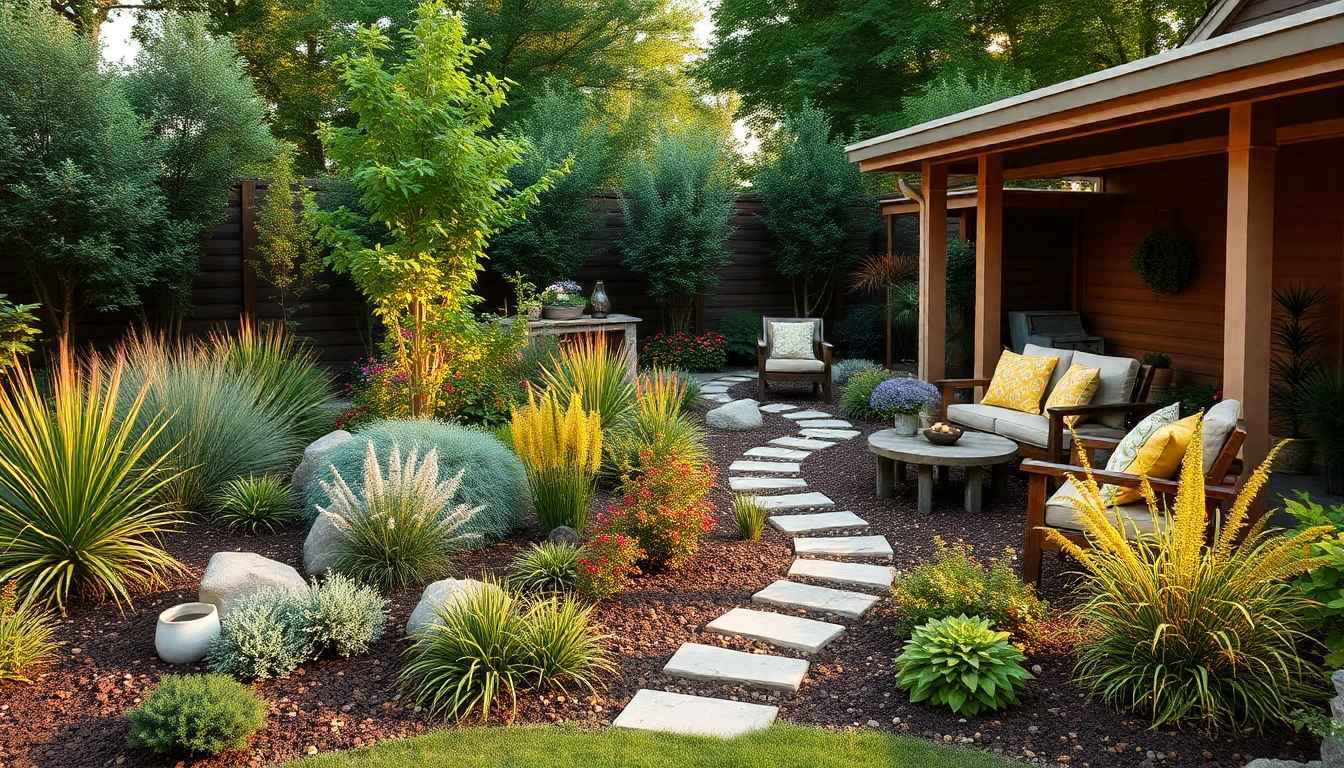Understanding Landscape Design Services
What is a Landscape Design Service?
Landscape design services encompass a variety of professional practices aimed at enhancing outdoor spaces. These services involve the planning, design, and management of both natural and built environments. The objective is to create a cohesive and functional space that integrates with the surrounding environment while also reflecting the preferences and needs of the client. Services can range from simple garden designs to extensive outdoor renovations, including the installation of patios, decks, water features, and plant selections.
In the dynamic world of landscape design, many homeowners and businesses are recognizing the benefits of hiring professionals to bring their visions to life. Engaging in a landscape design service allows access to expert knowledge in plant biology, local climates, and design principles, ensuring that outdoor spaces are not only aesthetically pleasing but also sustainable and functional.
Benefits of Professional Landscape Design
The advantages of hiring a professional landscape design service are plentiful. First and foremost, expert designers can provide a tailored approach to your specific needs, assisting in transforming your outdoor area into a unique, personalized environment. Professional designers also possess a deep understanding of landscape concepts such as balance, proportion, and harmony, ensuring that every element from plant selection to hardscape integration works together effectively.
Another significant benefit is efficient project management. Landscape projects can be complex, often involved with various contractors for different elements like irrigation, lighting, and construction. A professional designer can streamline communication and manage these contractors, leading to a smoother process and reducing the chances of costly mistakes. Additionally, they can help navigate local zoning laws and regulations, ensuring that your project is compliant with legal requirements.
Beyond aesthetics, professional landscape design emphasizes eco-friendly practices. Designers are skilled in selecting native and drought-resistant plants, which not only contribute to environmental sustainability but also reduce long-term maintenance costs. This focus on sustainability is increasingly important in today’s climate-conscious world.
Common Design Styles to Consider
When engaging a landscape design service, it is essential to explore various design styles to discover what resonates with your vision. Here are a few popular design styles to consider:
- Contemporary: Characterized by clean lines and minimalist aesthetics, contemporary landscapes often incorporate hardscapes like concrete and geometric plant arrangements.
- Traditional: This style emphasizes symmetry and well-defined garden beds, incorporating a variety of plants with a focus on classic design elements like hedges and pathways lined with flowers.
- Cottage: Offering a more informal and whimsical look, cottage gardens are rich in color and texture, filled with diverse plantings and casual paths that weave through the garden.
- Zen: Inspired by Japanese garden principles, Zen landscapes prioritize simplicity and peace, often featuring water elements, rocks, and minimalist plant arrangements.
- Native: Emphasizing the use of indigenous plants, native landscaping promotes biodiversity and is often low-maintenance, providing critical habitats for local wildlife.
Exploring these styles helps clients envision their ideal outdoor spaces and makes it easier for landscape designers to create tailored, captivating designs that reflect personal taste and local ecological contexts.
Choosing the Right Landscape Design Service
Factors to Evaluate When Selecting a Service
Choosing the right landscape design service is pivotal to achieving the desired outcome. Here are key factors to consider:
- Experience: Look for companies with a solid track record and a portfolio that reflects diverse projects. Experienced designers often have more creativity and problem-solving skills.
- Reputation: Check online reviews and testimonials. Recommendations from friends or family can provide high-value insights into the reliability and quality of a service provider.
- Specializations: Some landscape designers specialize in particular areas, such as sustainable design, residential projects, or commercial landscapes. Ensuring alignment with your needs is vital.
- Communication: Effective communication is essential throughout the design process. Your designer should be open to your ideas and able to convey their vision clearly.
- Budget Compatibility: Discuss the budget upfront and ensure the designer can work within your financial parameters without compromising quality.
Questions to Ask Your Landscape Designer
When interviewing potential landscape designers, asking the right questions can elicit crucial information and help establish compatibility. Consider the following:
- What is your design process and timeline for completion?
- Can you provide references from past clients?
- How do you approach sustainability in your designs?
- What warranties or guarantees do you offer for your work?
- Are you familiar with my local climate and soil conditions, and how would that impact your design?
These questions can help clarify the designer’s approach, their experience with local conditions, and their commitment to quality and service.
Assessing Service Provider Portfolios
A vital step in selecting a landscape design service involves assessing their portfolio. A strong portfolio showcases a designer’s versatility and aesthetic preferences. Look for:
- Variety: A well-rounded portfolio that displays different styles demonstrates a designer’s flexibility and creativity.
- Project Types: Check if they have experience with similar projects to yours, whether residential, commercial, or specialty gardens.
- Before-and-After Comparisons: This can provide insight into their transformative design capabilities.
- Recognition: Any awards or publications featuring their work can indicate a respected status within the industry.
- Client Testimonials: Positive feedback from previous clients gives you an idea of the designer’s work ethic and ability to meet expectations.
Investing time in such evaluations can lead to insightful decisions that align with your outdoor aspirations.
Implementing Your Landscape Design
Steps for a Successful Implementation
Once you have selected a landscape designer and finalized the designs, the implementation phase begins. Here’s how to ensure a successful process:
- Finalizing the Plan: Confirm all elements of the landscape design with your designer, ensuring you understand the full scope of work and materials.
- Permitting: As needed, acquire any necessary permits and confirm compliance with local regulations, which your designer can often assist with.
- Project Timeline: Establish a clear timeframe for the implementation, including key milestones for each stage of work.
- Site Preparation: Prepare the site by clearing debris, assessing drainage, and marking out areas for planting and construction.
- Execution: Depending on the scale, either coordinate the labor for installation or manage it directly, following your designer’s guidelines.
Budgeting for Your Landscape Project
Budget management is critical in any landscaping project. Begin by clarifying the overall budget and expectations with your designer upfront. Various factors will influence the cost:
- Materials: The choice of plants, materials, and features significantly impacts costs, with high-quality options often requiring a greater investment.
- Labor: Labor costs may vary based on the complexity of the work and the expertise required, so it’s essential to account for both minimal and extensive requirement scenarios.
- Design Fees: Ensure you factor in the designer’s fees for consultations and project management, typically based on the overall project scope.
- Maintenance Needs: Consider long-term maintenance costs as well, since choosing low-maintenance options may save money over time.
Transparent communication with your designer can facilitate effective budget management, avoiding surprises and ensuring the project remains on track financially.
Scheduling and Timeframe Expectations
Understanding the expected timeframe for your landscape project is crucial for effective planning. Factors that influence scheduling include:
- Seasonality: Certain landscaping projects are best undertaken in spring or fall, so the weather can play a large role in scheduling.
- Project Scope: Larger projects will naturally require more time for materials sourcing, installation, and final touches, which should be clearly communicated by your designer.
- Workforce Availability: The availability of your designer and their team should be considered, as busy seasons can extend timelines.
Your designer should provide you with a realistic timeline that fits your needs and anticipates potential delays well in advance.
Maintaining Your Landscape Design
Essential Maintenance Tips for Longevity
To ensure that your landscape design remains vibrant and attractive, proper maintenance is essential. Here are some key maintenance tips:
- Regular Watering: Establish a watering schedule that aligns with the needs of your plants, particularly during dry spells to prevent stress.
- Mulching: Apply mulch to gardens to retain moisture, suppress weeds, and maintain consistent soil temperatures.
- Pruning: Regularly prune plants to promote healthy growth and prevent overgrowth, which can detract from the aesthetic appeal of your landscape.
- Weed Control: Implement effective weed management strategies to keep your garden tidy and competition for nutrients to a minimum.
- Soil Health: Regularly test and amend your soil to ensure it has the necessary nutrients for plant health.
Seasonal Care and Considerations
Each season brings unique maintenance requirements to your landscape design. Here are some considerations for seasonal care:
- Spring: Focus on cleaning up debris, fertilizing, and planting new flowers and shrubs. Prune any winter-damaged plants to promote new growth.
- Summer: Monitor watering needs closely, as heat can quickly dry out soil. A mulch cover can also help retain moisture during peak heat.
- Fall: Prepare your garden for winter by cutting back perennials, planting bulbs for spring flowering, and raking leaves to prevent fungal disease.
- Winter: Check the integrity of hardscape features, cover tender plants, and plan for the upcoming season while exploring possible new design updates.
When to Hire a Professional for Maintenance
Determining when to hire professional maintenance services can be pivotal for managing your landscape effectively. Consider engaging professionals when:
- Time Constraints: If you find it challenging to dedicate time to maintenance due to a busy schedule, professional help can ensure your landscape thrives.
- Complex Gardens: Landscapes that feature intricate gardens or specific plant types may require specialized knowledge for optimal care.
- Beyond Basic Maintenance: If you require tasks like re-design, heavy pruning, or pest control that exceed basic maintenance, professionals will yield better results.
- Seasonal Preparation: Many homeowners turn to professionals for seasonal transition tasks to ensure their landscape is appropriately prepared for changing conditions.
Measuring Success in Landscape Design
How to Define Success Metrics
Measuring the success of your landscape design can incorporate both qualitative and quantitative metrics. Defining what success looks like can involve:
- Visual Appeal: Are you and your family satisfied with the aesthetics? Success can often be gauged through the enjoyment and beauty of the space.
- Functionality: Is the landscape serving its intended purpose, whether for recreation, relaxation, or entertaining? A successful design should support your lifestyle needs.
- Maintenance Requirements: Consider if the landscape is manageable within the given maintenance schedule. A good design allows for easy upkeep without overwhelming commitments.
Collecting Feedback and Testimonials
Regular feedback from family, friends, or even visitors can offer insights into the success and functionality of your landscape design. Encourage open discussions about:
- Overall impressions of the design and layout.
- Usability of different areas, such as seating, paths, and gardening spaces.
- Any adjustments that could enhance the landscape’s appeal or functionality.
Collecting testimonials, especially if hiring a professional designer, can also provide valuable information on how their design has impacted usability and aesthetics.
Making Adjustments for Optimal Results
It’s normal for landscapes to evolve over time. Making adjustments can help maintain or enhance the design’s effectiveness. Here’s how to approach it:
- Reevaluate Design Elements: Regularly assess the performance of the plants, structures, and materials in your landscape to determine what is thriving and what may need replacing.
- Adapt to Changes: As circumstances change, such as different uses of space, local plant growth, or environmental changes, adjust your landscape design accordingly.
- Engage Professionals for Large Updates: For significant revisions, involving your original designer or another professional can ensure that changes align with the overall vision.
With thoughtful evaluation and adjustments, your landscape can continue to serve you well, embodying desired qualities while remaining adaptable to change.



